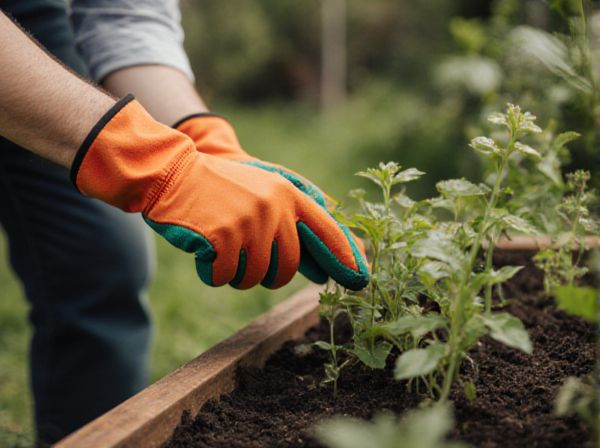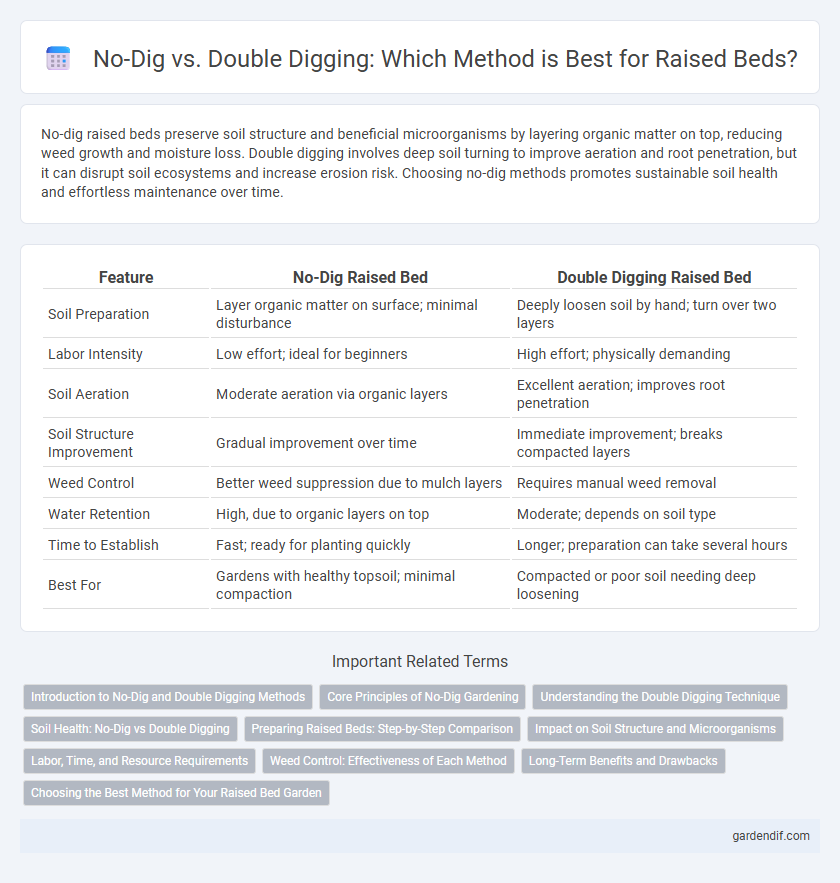
No-Dig vs Double Digging Illustration
No-dig raised beds preserve soil structure and beneficial microorganisms by layering organic matter on top, reducing weed growth and moisture loss. Double digging involves deep soil turning to improve aeration and root penetration, but it can disrupt soil ecosystems and increase erosion risk. Choosing no-dig methods promotes sustainable soil health and effortless maintenance over time.
Table of Comparison
| Feature | No-Dig Raised Bed | Double Digging Raised Bed |
|---|---|---|
| Soil Preparation | Layer organic matter on surface; minimal disturbance | Deeply loosen soil by hand; turn over two layers |
| Labor Intensity | Low effort; ideal for beginners | High effort; physically demanding |
| Soil Aeration | Moderate aeration via organic layers | Excellent aeration; improves root penetration |
| Soil Structure Improvement | Gradual improvement over time | Immediate improvement; breaks compacted layers |
| Weed Control | Better weed suppression due to mulch layers | Requires manual weed removal |
| Water Retention | High, due to organic layers on top | Moderate; depends on soil type |
| Time to Establish | Fast; ready for planting quickly | Longer; preparation can take several hours |
| Best For | Gardens with healthy topsoil; minimal compaction | Compacted or poor soil needing deep loosening |
Introduction to No-Dig and Double Digging Methods
No-dig gardening involves layering organic materials directly on top of the soil without overturning it, promoting soil health and microbial activity. Double digging is a labor-intensive method that involves loosening two layers of soil to improve aeration and drainage for root development. Comparing these techniques, no-dig preserves soil structure and reduces erosion, while double digging enhances soil depth and nutrient availability.
Core Principles of No-Dig Gardening
No-dig gardening centers on preserving soil structure by avoiding disturbance, allowing beneficial organisms to thrive and organic matter to accumulate naturally. This method enhances soil fertility and moisture retention without the labor-intensive process of double digging, which involves turning over and loosening soil layers. Core principles emphasize layering organic materials directly on the surface, promoting a healthy ecosystem that supports plant growth and reduces weed pressure.
Understanding the Double Digging Technique
Double digging is a gardening technique designed to improve soil structure by loosening two layers of soil, typically about 12 to 18 inches deep, which enhances root growth and drainage. This method involves removing the topsoil layer, aerating the subsoil beneath, and incorporating organic matter to enrich soil fertility and promote microbial activity. Compared to no-dig methods, double digging requires more labor but can significantly boost plant health in compacted or heavy clay soils.
Soil Health: No-Dig vs Double Digging
No-dig gardening preserves soil structure and microbial diversity by minimizing disturbance, promoting natural nutrient cycling and improving soil organic matter. Double digging aerates the soil deeply, enhancing root penetration and drainage but may disrupt beneficial microorganisms and accelerate organic matter decomposition. Maintaining long-term soil health favors no-dig methods, while double digging suits initial soil preparation or heavy compaction correction.
Preparing Raised Beds: Step-by-Step Comparison
Preparing raised beds using the no-dig method preserves soil structure, maintains beneficial microbes, and minimizes weed disturbance by layering organic materials directly atop the existing soil. Double digging involves manually loosening and aerating the soil to a depth of 24 inches, improving drainage and root penetration but requiring significant physical effort and time. Gardeners seeking low maintenance and soil health benefits often prefer no-dig, while those prioritizing deep soil aeration and immediate soil mixing may opt for double digging.
Impact on Soil Structure and Microorganisms
No-dig raised beds preserve soil structure by minimizing disturbance, which maintains beneficial microorganism habitats and supports natural soil ecosystems. In contrast, double digging disrupts soil layers, potentially harming microbial communities and altering soil aeration and water retention. Maintaining stable soil structure through no-dig practices promotes healthier plant growth and sustains long-term soil fertility.
Labor, Time, and Resource Requirements
No-dig raised beds significantly reduce labor and time compared to double digging by eliminating the need for intensive soil turnover and deep trenching. Double digging demands substantial physical effort and several hours to loosen soil layers, often requiring additional tools and amendments to improve soil structure. No-dig methods conserve resources by preserving soil microorganisms and organic matter, minimizing disturbance and the need for extra soil inputs.
Weed Control: Effectiveness of Each Method
No-dig raised beds excel in weed control by preserving soil structure and minimizing weed seed disturbance, reducing weed germination significantly compared to double digging. Double digging, while aerating the soil deeply, often brings buried weed seeds to the surface, increasing the likelihood of weed growth. Gardeners seeking long-term weed suppression tend to prefer no-dig methods for their ability to maintain a stable, less weed-prone environment.
Long-Term Benefits and Drawbacks
No-dig raised beds preserve soil structure and beneficial organisms by minimizing disturbance, promoting long-term fertility and moisture retention. Double digging aerates deeper soil layers, improving drainage and root penetration but risks disrupting soil ecosystems and accelerating organic matter depletion over time. Choosing between these methods depends on balancing immediate soil improvement against sustainable soil health and ecosystem stability.
Choosing the Best Method for Your Raised Bed Garden
No-dig raised beds preserve soil structure and beneficial microorganisms by adding organic matter on top, reducing labor and weed growth for sustainable gardening. Double digging improves soil aeration and drainage by manually loosening deeper layers, which enhances root development but requires more effort and time. Selecting the best method depends on soil condition, physical ability, and garden goals to balance efficiency with long-term soil health.
No-Dig vs Double Digging Infographic

 gardendif.com
gardendif.com